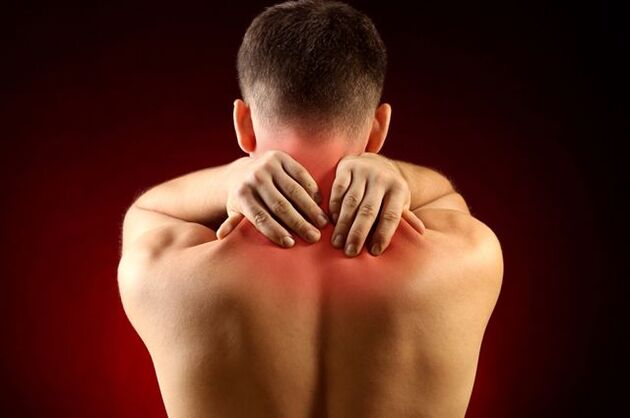Osteochondrosis is a degenerative-dystrophic disease in which the intervertebral disc suffers, the types of the disease, the symptoms and the methods of treatment. The central part of the intervertebral disc (nucleus pulposus) first swells and then shrinks, losing its shock-absorbing properties. The annulus fibrosus along the periphery of the disc becomes thinner and cracks appear in it.
The central part of the intervertebral disc (nucleus pulposus) first swells and then shrinks, losing its shock-absorbing properties. The annulus fibrosus along the periphery of the disc becomes thinner and cracks appear in it.
When the nucleus pulposus infiltrates this rupture, a protrusion appears, and if the ring breaks, the gelatinous body falls out and forms a herniated disc. As you age, the risk of developing osteochondrosis increases significantly.
Important
The localization of osteochondrosis may be different. The most common type is lumbosacral (in 50% of cases). Cervical osteochondrosis is common (in 25% of cases), less commonly in osteochondrosis of the thoracic spine. In 12% of cases, defeat of the intervertebral discs affects several parts of the spine at the same time - this is the most severe form of the disease.
Regardless of its location, the disease has several stages.
Section 1it is characterized by instability of spinal segments manifested in plate violation.
Section 2this is manifested in the fact that the vertebrae are less fixed to each other due to the protrusion of the intervertebral disc. The gap between the vertebrae decreases.
THESection 3the spine is already associated with severe deformities such as destruction of the annulus fibrosus and the formation of an intervertebral hernia. Pain syndromes and other symptoms are highly dependent on the location, shape, and size of the hernia.
THESection 4the patient moves with difficulty, and sudden movements lead to acute pain. Sometimes the pain decreases and the human condition improves, but this is only an apparent progression, with the fact that the bone tissue that connects two vertebrae grows between the vertebrae.
Check yourself
In cervical osteochondrosis are:
- aching pain in the neck or pain in the form of a lumbago that radiates to the shoulder blades, headrest, or hands;
- tension in the muscles of the neck when touched - painful feelings;
- feeling numbness or swelling of the tongue;
- feeling goose hills and tingling in the neck and arms;
- weakness of the neck and shoulder muscles.
With osteochondrosis of the thoracic region:
- there are periodic sharp pains as if there were a stake in the chest;
- there is a feeling that the chest is squeezing the hoop;
- intervertebral pain occurs while walking. The pain increases with breathing and does not go away after taking nitroglycerin, but usually lasts for a short time.
Osteochondrosis of the lumbosacral region is characterized by:
- pain in the lumbar region, sometimes making it impossible to straighten the back;
- pain radiating to the legs, sacrum, groin;
- loss of sensitivity of the legs, disabled;
- cold feet, goosebumps and tingling.
On a note
Many people think that sciatica is an independent disease. In fact, it is a manifestation of osteochondrosis. Injury to the intervertebral disc leads to the fact that adjacent vertebrae get closer to each other and can damage nerve fiber bundles protruding from the spinal cord. Disc herniation can also compress nerve roots. In this case, there is pain that spreads along certain nerve fibers and accordingly affects one or the other part of the body, most often the lower back and one leg, less often the neck or arm. .
There is even the term "lumbago". This is the name of the acute pain in the lower back. It can occur in an awkward position with a sharp movement, weight lifting, unsuccessful bends, long stays. During the attack, the person is often in a forced position, each movement attempt increases the pain, often a spasm of the muscles of the lumbar region develops. Lumbago is also most commonly caused by osteochondrosis of the spine.
Risk factors
Those of high stature, poor posture, or weakness of the muscles of the back and abdomen are prone to osteochondrosis; obese; office workers, who have a predominantly sedentary lifestyle, and movers, construction workers, who often carry heavy burdens. It is also common for professional drivers exposed to prolonged vibration.
Sports injuries with improper training lead to osteochondrosis. The disease often precedes former professional athletes who have suddenly completed intense workouts.
Osteopondrosis is much more dangerous than it looks. This often leads to dysfunction of many organs and systems. Sometimes the disease leads to severe unbearable pain and tightening of the nerve roots - partial or complete paralysis of the arm or leg.
Without treatment, osteochondrosis of the cervical spine can cause dizziness, headaches, and insomnia. Initiated chest osteochondrosis is fraught with complications such as intercostal neuralgia. Lumbar osteochondrosis can have dangerous consequences, such as progressive curvature of the spine and even greater destruction of the intervertebral discs, inflammation of the sciatic nerve (sciatica), severe disorders of the organs of the urogenital system.
Patient note
Conservative treatment is used in most cases to treat exacerbations of osteochondrosis. Its main goal is to suppress pain and eliminate pain-induced reflex muscle tension and stiffness. Non-steroidal anti-inflammatory drugs and muscle relaxants are used for this purpose.
In addition, medications are used to accelerate healing: B vitamins, agents that improve blood supply to the spine and nerve roots, biostimulants, and sedatives to support the nervous system, which are depleted by prolonged pain.
Physiotherapy methods are used to improve blood circulation and alleviate tissue edema, and to stimulate muscles: magnetic and ultrasound therapy, phono- and electrophoresis, darsonvalization, electromyostimulation. Acupuncture, manual therapy, massage, mud application are also used.
Traction treatment is used to unravel the spine and increase the distance between the vertebrae. Successful prediction of recovery is impossible without physiotherapy practices that actively involve the patient in the treatment process.
Surgical treatment is used in severe, advanced cases.






















